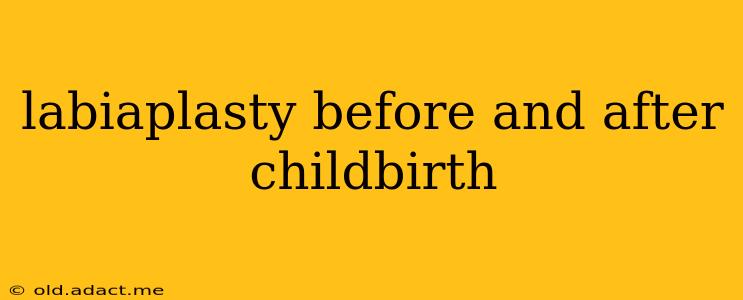Labiaplasty, a surgical procedure to reshape the labia minora (the inner lips of the vulva), is a topic of increasing interest. Many women consider this procedure for cosmetic reasons, but childbirth significantly impacts the vulva and perineum, raising important questions about undergoing labiaplasty before or after delivery. This comprehensive guide explores the key considerations surrounding labiaplasty and its relationship to childbirth.
Should I Have a Labiaplasty Before or After Childbirth?
This is a crucial question with no single right answer. The decision hinges on several personal factors:
-
Your reasons for considering labiaplasty: If your primary motivation is purely cosmetic, delaying the procedure until after childbirth might be wise. Pregnancy and childbirth naturally alter the vulva's appearance, and waiting allows you to assess your post-partum body and determine if you still desire the procedure. If you have concerns about functionality (e.g., discomfort during intercourse or physical activity), discussing these with your doctor is crucial, regardless of your pregnancy status.
-
Your recovery timeline: Childbirth requires significant recovery time, both physically and emotionally. Undergoing labiaplasty concurrently or soon after childbirth could be challenging, potentially hindering your overall recovery process. Post-partum healing needs to take precedence.
-
Potential changes to your body: Pregnancy and childbirth can cause significant changes in your body, including weight fluctuations and hormonal shifts. These changes could affect the final results of a labiaplasty. Waiting until after your body has stabilized might lead to a more predictable outcome.
-
Your doctor's recommendation: Ultimately, your doctor's assessment is paramount. They can evaluate your individual circumstances and help you make an informed decision based on your health, medical history, and personal goals.
What are the Potential Risks of Labiaplasty After Childbirth?
While labiaplasty is generally safe, undertaking the procedure after childbirth presents some additional considerations:
-
Increased risk of complications: The perineum, the area between the vagina and the anus, is already stretched and potentially damaged after childbirth. This can increase the risk of infection or other complications during and after labiaplasty.
-
Delayed healing: The body's healing process might be slower postpartum due to hormonal changes and the demands of caring for a newborn. This can lengthen recovery time after labiaplasty.
-
Impact on breastfeeding: Some medications used during and after the procedure might not be compatible with breastfeeding. Your doctor will need to carefully weigh the benefits and risks.
How Does Childbirth Affect the Labia?
Pregnancy and vaginal delivery can cause changes to the labia:
-
Stretching and tearing: The vaginal canal and surrounding tissues undergo significant stretching during delivery. This can lead to changes in the labia's shape, size, and appearance.
-
Perineal trauma: Tears or episiotomies (surgical cuts to the perineum) can further alter the labia's appearance and potentially affect sensation.
-
Hormonal changes: Postpartum hormonal fluctuations can impact skin elasticity and tissue healing.
Does Labiaplasty Affect Fertility or Future Pregnancies?
Labiaplasty itself does not directly affect fertility or future pregnancies. The procedure focuses on the outer labia and doesn't involve the internal reproductive organs. However, any scarring resulting from the procedure is unlikely to impact fertility. The key consideration remains ensuring complete healing before attempting another pregnancy.
What is the Recovery Time for Labiaplasty After Childbirth?
Recovery time after labiaplasty is generally several weeks, but it can be longer postpartum due to the already compromised healing environment. Following your doctor’s post-operative instructions is paramount. This usually includes managing pain, keeping the area clean, and avoiding strenuous activities.
Can I Still Get a Labiaplasty if I've Had Multiple Childbirths?
Yes, you can still consider labiaplasty even after multiple births. However, the increased potential for existing scarring and tissue changes warrants a thorough consultation with a qualified surgeon to assess the feasibility and potential risks.
What are the Alternatives to Labiaplasty?
Before opting for surgery, consider exploring alternative options to address any concerns:
-
Non-surgical treatments: Some women find relief from discomfort or aesthetic concerns through physiotherapy, exercises targeting pelvic floor muscles, or other non-surgical interventions.
-
Acceptance: Many women come to accept the changes in their bodies following childbirth and choose not to pursue any surgical intervention.
In conclusion, the decision to undergo labiaplasty before or after childbirth is highly personal and requires careful consideration of numerous factors. A detailed consultation with a qualified surgeon is crucial to make an informed decision that aligns with your individual needs, health, and expectations. Remember that embracing body positivity and self-acceptance are equally important aspects of the decision-making process.
